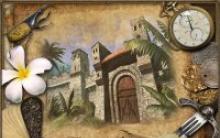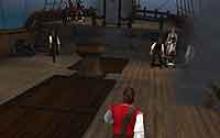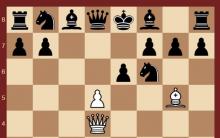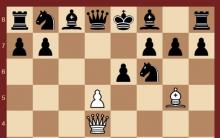Puzzles (logical puzzles).
In this section, you are presented with a lot of puzzles, logical puzzles. Each puzzle has an answer, to see it, you must click on the word "Answer" located below the puzzle.
Solving puzzles, logic puzzles makes the brain think and trains thinking, logic, memory. New connections appear in the brain, i.e. experience in solving new tasks for him, which leads to the development of the brain.
Puzzles, logic puzzles of this section are designed for different age groups and are suitable for solving: adults, students, teenagers, schoolchildren, children. That is, there are both complex puzzles and simple puzzles.
A puzzle is a task that, very often, requires quick wits, logical thinking, sometimes the use of non-standard thinking, and not high-level special knowledge. Therefore, solving puzzles, logic puzzles in this section will help you both test and improve your logical thinking, quick wits, memory and lateral thinking.
A puzzle in biology and mathematics at the same time.
A new type of very interesting bacteria is being investigated in the laboratory.
Each of these bacteria multiplies into two bacteria
at intervals of one minute.
At 20:00 pm, the test tube was half filled with bacteria.
When do you think this test tube will be completely
filled with bacteria
Answer
Puzzle about pets.
Sveta has pets: cats and dogs.
Of all her animals, only one is not a dog,
while all her pets, except for one - cats.
How many cats and dogs do you think Sveta has?
Answer
Fruit puzzle.
Imagine that you have an empty fruit basket.
Nearby is a basket twice as large in volume,
which is completely filled to the top with apples.
There are 240 apples in a large basket.
How many apples do you think you can put in an empty basket?
1. Puzzle “Decipher the phrase”
Skipping the same number of divisions clockwise, read the encrypted phrase. Start with the outer circle.
Answer: All cells have a similar structure and chemical composition.
2. Monogram “Cage”
A monogram is a writing of words by letters drawn in geometric shapes one inside the other.
To read a monogram, you need to find all the letters drawn in it and make a word or a whole phrase out of them.

Answer: cell.
3. Monograms “Cell Substances”
Find all the letters in the monograms and read the names of the chemicals that make up plant cells.

Answer: 1. Proteins. 2. Carbohydrates. 3. Fats. 4. Water. 5. Mineral salts.
4. Cryptogram "Cage and magnifying devices"
Arrange the letters of the keywords by numbers in the cells and read the cryptogram.

Answer: eyepiece, preparation, lens, magnifying glass, chromosomes, cytoplasm, nuclei, skin, Linnaeus (cell).
Having solved this rebus, you will find out which substances that make up the cells and tissues of plants are organic.

Answer: carbohydrates, proteins, fats - organic substances.
Write in the cells of the crossword puzzle the names of the corresponding parts of the microscope and cell organelles, as well as the name of the scientist who first discovered the cellular structure of plants.
If the task is completed correctly, then in the selected vertical row you will read the name of the science that studies the structure and life of the cell ( cytology).

Answer: 1. Cytoplasm. 2. Lens. 3. Tube. 4. Shell. 5. Eyepiece. 6. Vacuole. 7. Hook. 8. Tripod. 9. Core.
7. Labyrinth
Find the beginning of the maze and read one of the main provisions of biology.
Answer: the transmission of hereditary properties by cells is associated with chromosomes.
Write the names of the parts and organelles of the plant cell so that the letter “o” is common to all lines. Use the numbers of the numbered words to indicate the corresponding parts of the cell in the figure.

Answer: 1. It's time. 2. Core. 3. Cytoplasm. 4. Leukoplasts. 5. Chromoplasts. 6. Chloroplasts.
Horizontally: 5. Space between cells. 7. The most important process of vital activity of cells and the whole organism. 10. Cell plastid stained orange. 11. A large vial filled with cell sap. 12. A small dense body located in the cell nucleus. 15. The optical part of the microscope, directed to the preparation. 17. Spotting scope of a microscope. 19. The optical part of the microscope, which is looked into. 20. A substance that is part of the cell wall. 22. Colorless viscous intracellular contents. 23. Thinner sections of the cell membrane.
Vertically: 1. Optical magnifying device. 2. The process leading to an increase in the number of cells. 3. A small dense body in the cytoplasm of the cell. 4. Dutch scientist who improved the Jansen microscope. 6. Magnifying glass in a frame. 8. Cylindrical body, transmitting hereditary traits from cell to cell. 9. Green plastid. 13. The process leading to an increase in cell size. 14. Part of the cell. 16. Organic substances that make up the cell. 18. Optical part of the microscope. 21. A substance that accounts for 80-95% of the mass of a plant.

Answer: Horizontally: 5. Intercellular. 7. Breath. 10. Chromoplast. 11. Vacuole. 12. Nucleolus. 15. Lens. 17. Tube. 19. Eyepiece. 20. Cellulose. 22. Cytoplasm. 23. It's time. Vertical: 1. Microscope. 2. Division. 3. Core. 4. Leeuwenhoek. 6. Loupe. 8. Chromosomes. 9. Chloroplast. 13. Growth. 14. Shell. 16. Proteins. 18. Mirror. 21. Water.
In preparation for the game, students are encouraged to read:
- Butenko R.G. Cell life outside the body. Moscow: Knowledge, 1975.
- Verzilin N.M. In the footsteps of Robinson. - Gardens and parks of the world. - Traveling with house plants. L .: Children's literature, 1964, 1970.
- Denisova G.A. The wonderful world of plants. M.: Education, 1973.
- Plant Life / Ed. A.A.nbsp; Fedorova. Moscow: Education, 1974-1982. T.1.
- Ivchenko S.I. Entertaining biology. Moscow: Young guard, 1972.
- Timiryazev K.A. Plant life. L .: Young Guard, 1950.
- Travkin M.N. Interesting experiments with plants. M.: Uchpedgiz, 1960.
Entertaining tasks
1. Puzzle “Decipher the phrase”
Skipping the same number of divisions clockwise, read the encrypted phrase. Start with the outer circle.
Answer:All cells have a similar structure and chemical composition.
2. Monogram “Cage”
A monogram is a writing of words by letters drawn in geometric shapes one inside the other.
To read a monogram, you need to find all the letters drawn in it and make a word or a whole phrase out of them.

Answer:cell.
3. Monograms “Cell Substances”
Find all the letters in the monograms and read the names of the chemicals that make up plant cells.

Answer:1. Proteins. 2. Carbohydrates. 3. Fats. 4. Water. 5. Mineral salts.
4. Cryptogram "Cage and magnifying devices"
Arrange the letters of the keywords by numbers in the cells and read the cryptogram.

Answer:eyepiece, specimen, lens, loupe, chromosomes, cytoplasm, nuclei, skin, Linnaeus (cell).
5. Rebus
Having solved this rebus, you will find out which substances that make up the cells and tissues of plants are organic.

Answer:carbohydrates, proteins, fats - organic substances.
6. Crossword "Science of the cell"
Write in the cells of the crossword puzzle the names of the corresponding parts of the microscope and cell organelles, as well as the name of the scientist who first discovered the cellular structure of plants.
If the task is completed correctly, then in the selected vertical row you will read the name of the science that studies the structure and life of the cell (cytology ).

Answer:1. Cytoplasm. 2. Lens. 3. Tube. 4. Shell. 5. Eyepiece. 6. Vacuole. 7. Hook. 8. Tripod. 9. Core.
7. Labyrinth
Find the beginning of the maze and read one of the main provisions of biology.
Answer:the transmission of hereditary properties by cells is associated with chromosomes.
8. Crossword “Plant cell”
Write the names of the parts and organelles of the plant cell so that the letter “o” is common to all lines. Use the numbers of the numbered words to indicate the corresponding parts of the cell in the figure.

Answer:1. It's time. 2. Core. 3. Cytoplasm. 4. Leukoplasts. 5. Chromoplasts. 6. Chloroplasts.
9. Crossword "Structure of the cell" Horizontally: 5. Space between cells. 7. The most important process of vital activity of cells and the whole organism. 10. Cell plastid stained orange. 11. A large vial filled with cell sap. 12. A small dense body located in the cell nucleus. 15. The optical part of the microscope, directed to the preparation. 17. Spotting scope of a microscope. 19. The optical part of the microscope, which is looked into. 20. A substance that is part of the cell wall. 22. Colorless viscous intracellular contents. 23. Thinner sections of the cell membrane. Vertically: 1. Optical magnifying device. 2. The process leading to an increase in the number of cells. 3. A small dense body in the cytoplasm of the cell. 4. Dutch scientist who improved the Jansen microscope. 6. Magnifying glass in a frame. 8. Cylindrical body, transmitting hereditary traits from cell to cell. 9. Green plastid. 13. The process leading to an increase in cell size. 14. Part of the cell. 16. Organic substances that make up the cell. 18. Optical part of the microscope. 21. A substance that accounts for 80-95% of the mass of a plant.
Answer:Horizontally: 5. Intercellular space. 7. Breath. 10. Chromoplast. 11. Vacuole. 12. Nucleolus. 15. Lens. 17. Tube. 19. Eyepiece. 20. Cellulose. 22. Cytoplasm. 23. It's time. Vertical: 1. Microscope. 2. Division. 3. Core. 4. Leeuwenhoek. 6. Loupe. 8. Chromosomes. 9. Chloroplast. 13. Growth. 14. Shell. 16. Proteins. 18. Mirror. 21. Water.












Corsairs To Each His Own Passage Of The Quest In Search Of The Guardian Of Truth - tioneproperties
Walkthrough "Corsairs: To Each His Own"
Walkthrough "Corsairs: To Each His Own"
Cell biology puzzles
Why hasn't the computer beat the human yet?